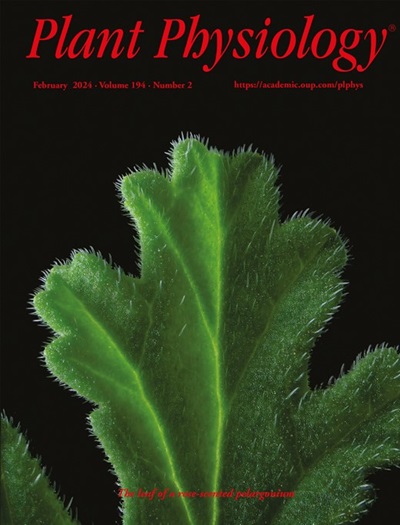Functions of Arabidopsis CTP:phosphocholine cytidylyltransferase 1 in phosphatidylcholine biosynthesis and root growth.
IF 6.9
1区 生物学
Q1 PLANT SCIENCES
引用次数: 0
Abstract
Phosphatidylcholine (PC) is a crucial membrane phospholipid involved in both cellular processes and stress responses. CTP:phosphocholine cytidylyltransferase 1 (CCT1) is considered to catalyze a key regulatory step in primary PC de novo biosynthesis, but its functions and regulation are yet to be well elucidated. This study explored the physiological functions of CCT1 in Arabidopsis (Arabidopsis thaliana) (AthCCT1) in PC biosynthesis under normal growth conditions and in root development under osmotic stress, as well as its regulation by phosphorylation. Arabidopsis cct1 knockdown cct2 knockout lines exhibited significantly decreased PC intensities under normal growth conditions and impaired root growth under osmotic stress, which was rescued by AthCCT1 overexpression. Moreover, based on our previous findings that AthCCT1 is phosphorylated at Serine 187 (S187), we further investigated how this phosphorylation affects its biochemical and biological functions. The S187D phosphomimetic protein mutant of AthCCT1 exhibited reduced lipid-induced conformational changes and decreased enzymatic activity compared to the native protein. Molecular dynamics simulations of the S187D protein mutant revealed that the auto-inhibitory region, a conserved regulatory domain across CCT enzymes, remained closer to the αE helix, maintaining a constrained interaction between them. Consistent with the results of the in vitro analyses, overexpression of AthCCT1-S187D did not rescue stress-induced short root phenotypes in cct1 knockdown cct2 knockout Arabidopsis lines. Taken together, the results revealed that AthCCT1 regulates PC biosynthesis under normal conditions and root development under osmotic stress, with its phosphorylation state at S187 playing an important role in modulating its enzymatic activity and physiological functions.拟南芥CTP:磷脂酰转移酶1在磷脂酰胆碱生物合成和根系生长中的作用。
磷脂酰胆碱(PC)是一种重要的膜磷脂,参与细胞过程和应激反应。CTP:phosphocholine cytidyltransferase 1 (CCT1)被认为催化了初级PC de novo生物合成的关键调控步骤,但其功能和调控尚未得到很好的阐明。本研究探讨了CCT1在拟南芥(Arabidopsis thaliana)正常生长条件下PC生物合成和渗透胁迫下根系发育中的生理功能及其磷酸化调控。拟南芥cct1敲除cct2敲除系在正常生长条件下PC强度显著降低,在渗透胁迫下根系生长受损,这是由AthCCT1过表达修复的。此外,基于我们之前的发现,AthCCT1在187丝氨酸(S187)磷酸化,我们进一步研究了这种磷酸化如何影响其生化和生物学功能。与天然蛋白相比,AthCCT1的S187D拟磷蛋白突变体表现出减少脂质诱导的构象变化和降低的酶活性。S187D蛋白突变体的分子动力学模拟显示,自抑制区(CCT酶的保守调控区域)更靠近αE螺旋,保持了它们之间的约束相互作用。与体外分析结果一致,在cct1敲除的拟南芥品系中,过表达AthCCT1-S187D并没有挽救应力诱导的短根表型。综上所述,AthCCT1在正常条件下调控PC的生物合成和渗透胁迫下的根系发育,其S187位点的磷酸化状态在调节其酶活性和生理功能中发挥重要作用。
本文章由计算机程序翻译,如有差异,请以英文原文为准。
求助全文
约1分钟内获得全文
求助全文
来源期刊

Plant Physiology
生物-植物科学
CiteScore
12.20
自引率
5.40%
发文量
535
审稿时长
2.3 months
期刊介绍:
Plant Physiology® is a distinguished and highly respected journal with a rich history dating back to its establishment in 1926. It stands as a leading international publication in the field of plant biology, covering a comprehensive range of topics from the molecular and structural aspects of plant life to systems biology and ecophysiology. Recognized as the most highly cited journal in plant sciences, Plant Physiology® is a testament to its commitment to excellence and the dissemination of groundbreaking research.
As the official publication of the American Society of Plant Biologists, Plant Physiology® upholds rigorous peer-review standards, ensuring that the scientific community receives the highest quality research. The journal releases 12 issues annually, providing a steady stream of new findings and insights to its readership.
 求助内容:
求助内容: 应助结果提醒方式:
应助结果提醒方式:


